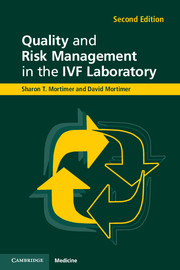45 results
Chapter 21 - The Future of Computer-Assisted Semen Analysis in the Evaluation of Male Infertility
- from Section 4 - Laboratory Evaluation and Treatment of Male Infertility
-
-
- Book:
- Men's Reproductive and Sexual Health Throughout the Lifespan
- Published online:
- 06 December 2023
- Print publication:
- 16 November 2023, pp 165-174
-
- Chapter
- Export citation
Chapter 7 - Handling of Gametes and Embryos
-
-
- Book:
- Manual of Embryo Selection in Human Assisted Reproduction
- Published online:
- 26 April 2023
- Print publication:
- 26 January 2023, pp 62-69
-
- Chapter
- Export citation
Chapter 11 - The Case Against Intracytoplasmic Sperm Injection for All
-
-
- Book:
- Male and Sperm Factors that Maximize IVF Success
- Published online:
- 24 May 2020
- Print publication:
- 30 April 2020, pp 130-140
-
- Chapter
- Export citation
Chapter 10 - How are we doing?: benchmarking
-
- Book:
- Quality and Risk Management in the IVF Laboratory
- Published online:
- 05 March 2015
- Print publication:
- 02 March 2015, pp 145-152
-
- Chapter
- Export citation
Chapter 2 - Regulation, licensing, and accreditation
-
- Book:
- Quality and Risk Management in the IVF Laboratory
- Published online:
- 05 March 2015
- Print publication:
- 02 March 2015, pp 6-15
-
- Chapter
- Export citation
Chapter 4 - What is risk?
-
- Book:
- Quality and Risk Management in the IVF Laboratory
- Published online:
- 05 March 2015
- Print publication:
- 02 March 2015, pp 39-48
-
- Chapter
- Export citation
Chapter 8 - What’s gone wrong?:troubleshooting
-
- Book:
- Quality and Risk Management in the IVF Laboratory
- Published online:
- 05 March 2015
- Print publication:
- 02 March 2015, pp 118-125
-
- Chapter
- Export citation
Chapter 7 - Quality and risk management tools
-
- Book:
- Quality and Risk Management in the IVF Laboratory
- Published online:
- 05 March 2015
- Print publication:
- 02 March 2015, pp 100-117
-
- Chapter
- Export citation
Chapter 6 - Making it work
-
- Book:
- Quality and Risk Management in the IVF Laboratory
- Published online:
- 05 March 2015
- Print publication:
- 02 March 2015, pp 71-99
-
- Chapter
- Export citation
Chapter 5 - Process and systems
-
- Book:
- Quality and Risk Management in the IVF Laboratory
- Published online:
- 05 March 2015
- Print publication:
- 02 March 2015, pp 49-70
-
- Chapter
- Export citation
Chapter 1 - Introduction
-
- Book:
- Quality and Risk Management in the IVF Laboratory
- Published online:
- 05 March 2015
- Print publication:
- 02 March 2015, pp 1-5
-
- Chapter
- Export citation
Chapter 13 - Illustrative example of a well-controlled laboratory
-
- Book:
- Quality and Risk Management in the IVF Laboratory
- Published online:
- 05 March 2015
- Print publication:
- 02 March 2015, pp 193-212
-
- Chapter
- Export citation

Quality and Risk Management in the IVF Laboratory
-
- Published online:
- 05 March 2015
- Print publication:
- 02 March 2015
Bibliography
-
- Book:
- Quality and Risk Management in the IVF Laboratory
- Published online:
- 05 March 2015
- Print publication:
- 02 March 2015, pp 223-228
-
- Chapter
- Export citation
Chapter 3 - Quality and quality management
-
- Book:
- Quality and Risk Management in the IVF Laboratory
- Published online:
- 05 March 2015
- Print publication:
- 02 March 2015, pp 16-38
-
- Chapter
- Export citation
Contents
-
- Book:
- Quality and Risk Management in the IVF Laboratory
- Published online:
- 05 March 2015
- Print publication:
- 02 March 2015, pp v-vi
-
- Chapter
- Export citation
Index
-
- Book:
- Quality and Risk Management in the IVF Laboratory
- Published online:
- 05 March 2015
- Print publication:
- 02 March 2015, pp 229-234
-
- Chapter
- Export citation
Chapter 14 - Is the “well-run lab” enough?: quality and risk management in the IVF clinic
-
- Book:
- Quality and Risk Management in the IVF Laboratory
- Published online:
- 05 March 2015
- Print publication:
- 02 March 2015, pp 213-222
-
- Chapter
- Export citation
Chapter 11 - Specifyingsystems
-
- Book:
- Quality and Risk Management in the IVF Laboratory
- Published online:
- 05 March 2015
- Print publication:
- 02 March 2015, pp 153-178
-
- Chapter
- Export citation
Chapter 9 - Risk management: being proactive
-
- Book:
- Quality and Risk Management in the IVF Laboratory
- Published online:
- 05 March 2015
- Print publication:
- 02 March 2015, pp 126-144
-
- Chapter
- Export citation



